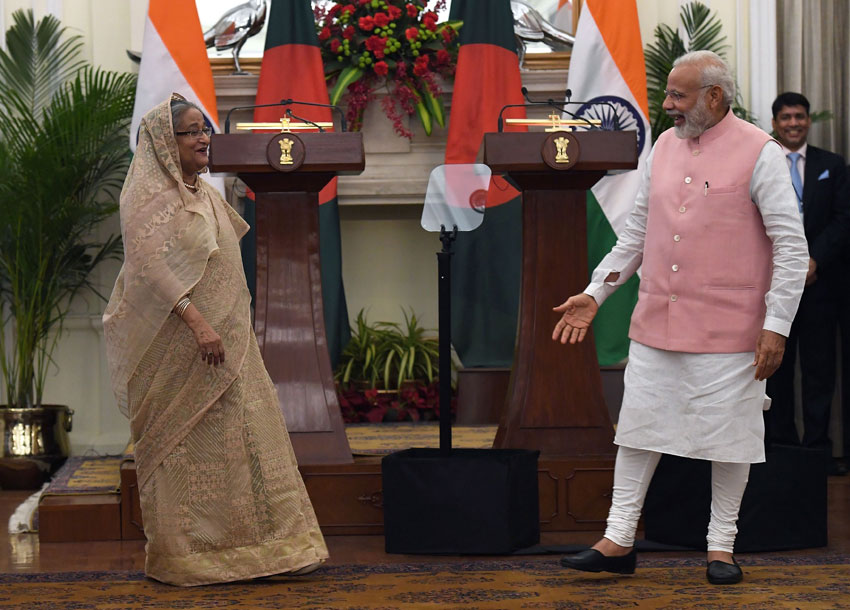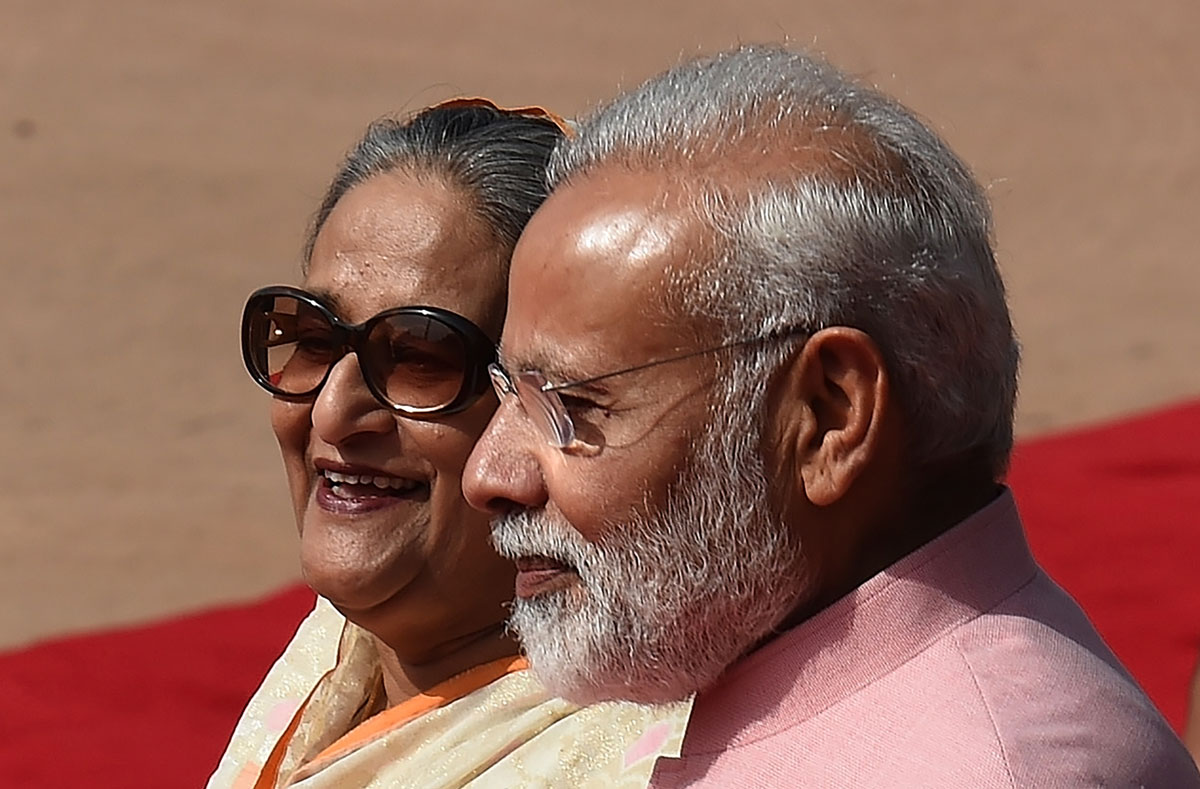Modi’s Foreign Policy Success with Bangladesh
Prime Minister Narendra Modi talks with Bangladesh Prime Minister Sheikh Hasina (l) during a ceremonial reception at Presidential House in New Delhi, April 8. (Prakash Singh/AFP/Getty Images)
Given the problems with Pakistan, there has been pressure on New Delhi to keep other frontiers peaceful. One country that India has managed to engage in a positive manner over recent months is Bangladesh. Unlike with Pakistan, improved relations between India and Bangladesh has been a major regional diplomatic success of the Modi government, writes Siddharth Srivastava.
Prime Minister Narendra Modi’s frequent trips abroad have been a subject of much mirth and parody on social media. Despite efforts within South Asia, India’s equations with Pakistan continues to be volatile; Nepal is another country with which associations continue to be tenuous. Indo-Pak relations plumbed to a new low recently with New Delhi slamming Pakistan at UN General Assembly for promoting terrorism, and labeled the country as “Terroristan” that produces terrorists and exports them all over the world. “In its short history, Pakistan has become a geography synonymous with terror,” Eenam Gambhir, the first secretary in India’s Permanent Mission to the UN, said in response to Pakistani Prime Minister Shahid Abbasi’s statement accusing India of “brutally” suppressing “the struggle” of the people of Kashmir.
Pakistan’s “contribution to the globalization of terror is unparalleled. The quest for land of pure has actually produced a ‘land of pure terror.’ Pakistan is now ‘Terroristan’ with a flourishing industry producing and exporting global terrorism,” Gambhir said. Gambhir is the same officer who stole the limelight last year she took on then Pakistan Prime Minister Nawaz Sharif by saying, “The land of Taxila, one of the greatest learning centers of ancient times, is now host to the Ivy League of terrorism.”
Given the problems with Pakistan, there has been pressure on New Delhi to keep other frontiers peaceful. One country that India has managed to engage in a positive manner over recent months is Bangladesh. Unlike with Pakistan, improved relations between India and Bangladesh has been a major regional diplomatic success of the Modi government.

Modi’s Success with Bangladesh
The reduced trust deficit between the two countries has translated into significant positive moves in power and hydrocarbon sectors, that have otherwise existed only on paper for many years.
Oil minister Dharmendra Pradhan recently said India and Bangladesh are in talks to lay a pipeline to transport natural gas from Chittagong to Tripura to meet the LPG needs of the remote north-eastern region. “We are laying a pipeline for transportation of diesel from Siliguri in West Bengal to Parbatipur in Bangladesh. There is a pipeline for carrying diesel from Numaligarh Refinery in Assam to Siliguri. In exchange, we have given the proposal for gas pipeline from Chittagong to Tripura. We are pursuing the matter diplomatically. I will visit Bangladesh soon,” Pradhan said.
The pipeline if approved by Dhaka will be laid by the side of the rail lines which pass near the Indo-Bangla international border, Pradhan said. The framework of engagement between India and Bangladesh was laid during the visit of Bangladesh Prime Minister Sheikh Hasina’s to New Delhi in April. “Energy security is an important dimension of our development partnership,” Modi said following the signing of a non-binding framework of understanding (FoU) on the hydrocarbon sector that sets the agenda of future co-operation. India has committed to supply of High Speed Diesel (HSD) through the proposed Rs 3.6 billion, 131-kilometre, one million metric ton per annum pipeline that New Delhi has agreed to finance.
India has also pledged to assist Bangladesh to become a gas-based economy by reducing its reliance on expensive imported fuel oil to generate power and cutting polluting energy sources. Proposals include import of cheaper LNG at the under-construction Dharma re-gassification terminal in Odisha, which will be transported to Dattapulia in West Bengal and further to Khulna in Bangladesh via a 70-km pipeline.
Regional Momentum
Improved relations between India and Bangladesh is likely to brighten the prospects of larger projects such as extending the Turkmenistan-Afghanistan-Pakistan-India (TAPI) and construction of the Myanmar-Bangladesh-India (MBI) gas pipelines.
Recently, Nasrul Hamid, Bangladesh’s State minister for power and energy said his country is keen to join the TAPI project given the huge domestic demand for gas. According to reports, the MBI project, mothballed for several years due to deteriorating Indo-Bangla relations, has figured in official talks between the two countries, including Modi and Hasina, over the recent months. New offshore discoveries and Myanmar’s desire to tap energy markets beyond just China have helped revive the plans.
These projects will provide a big push forward to India’s plans to establish a vast network of regional oil and gas pipelines with its neighbors. India’s “Hydrocarbon Vision 2030” envisages laying of nearly 7,000 km of pipelines that will connect Sitwe in Myanmar to Chittagong in Bangladesh, the north-east states and West Bengal. “Through diplomatic channels, India has already tied up to set up an energy cooperation network with Myanmar, Bangladesh and Nepal. All the countries have already agreed to this ambitious mission,” Pradhan said recently.
With Bangladesh on its side, New Delhi will surely find it easier to take on Pakistan. And the occasions, it seems are going to be many, given the recent exchanges at the UNGA.


